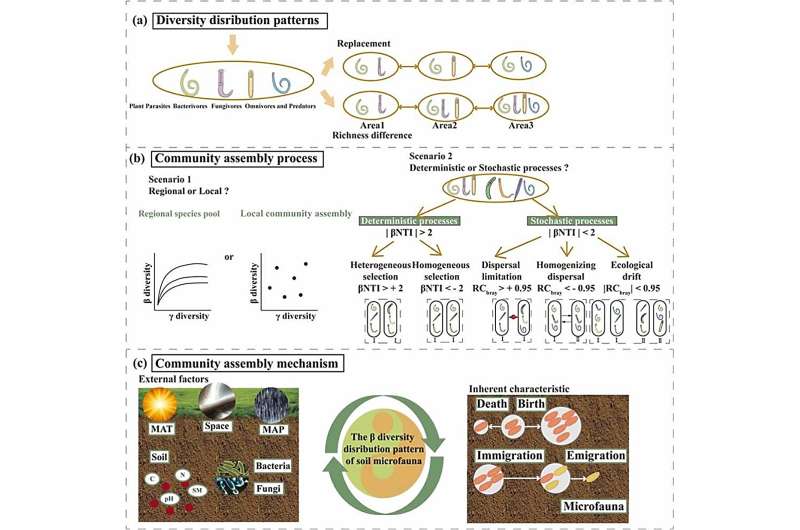This article has been reviewed according to Science X's editorial process and policies. Editors have highlighted the following attributes while ensuring the content's credibility:
fact-checked
trusted source
proofread
How soil microfauna diversity and community assembly change across latitudes in croplands

Soil microfauna are microscopic animals that live in the soil and play important roles in nutrient cycling, plant growth, and ecosystem functioning. A team of researchers from the Institute of Applied Ecology of the Chinese Academy of Sciences conducted a study on how the diversity and community assembly of soil microfauna are affected by the latitudinal gradient. The findings were published in Agriculture, Ecosystems & Environment.
The study covered a transect of 3,200 km in croplands in eastern China, spanning from 44°51′ N to 19°34′ N and used high-throughput sequencing technology to identify soil microfauna community composition. The researchers analyzed beta diversity, or the dissimilarity in species composition, of different soil trophic groups, and used a null model to explore the main drivers of the beta diversity geographical distribution patterns.
They found that the beta diversity of plant-parasitic nematodes, fungivorous nematodes and bacterivorous nematodes increased with geographical separation, and that the local community assembly processes, species replacement in particular, played a dominant role in shaping soil microfauna communities, which reflected that some of the species had preferences and a strong agricultural habitat specialization.
In addition, the researchers found that climatic and soil factors directly influenced soil microflora and plant-parasitic nematodes, and indirectly influenced community composition of bacterivorous nematodes, fungivorous nematodes and predatory-omnivorous nematodes. They also found a close trophic cascade relationship between soil microflora and soil nematodes, and the complexity of this biological network was mediated by latitudinal gradient.
The study provides insights into the distribution patterns and community assembly mechanism of soil microfauna diversity, and enhances the understanding of the mechanisms of soil biodiversity maintenance at large spatial scales.
More information: Xiaotong Liu et al, Microfauna community assembly and cascading relationship with microflora in cropland ecosystems along a latitudinal gradient, Agriculture, Ecosystems & Environment (2023). DOI: 10.1016/j.agee.2023.108678
Provided by Chinese Academy of Sciences





















